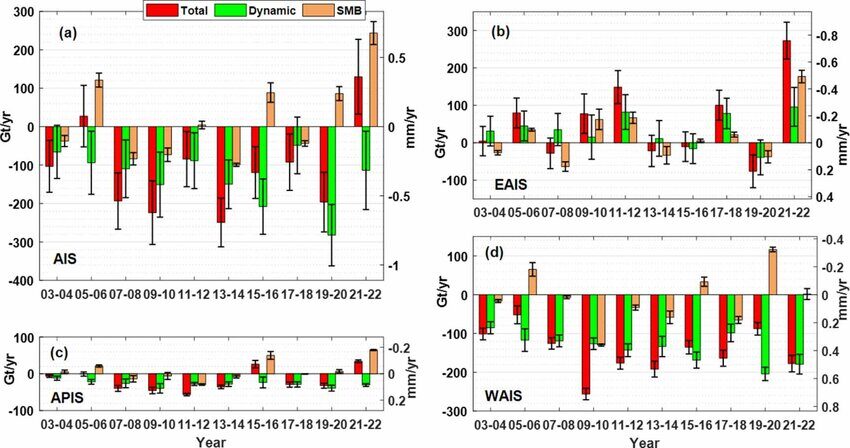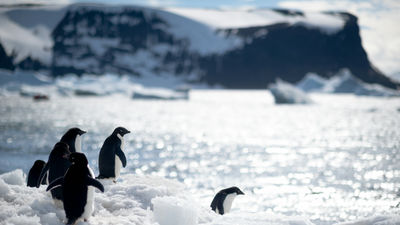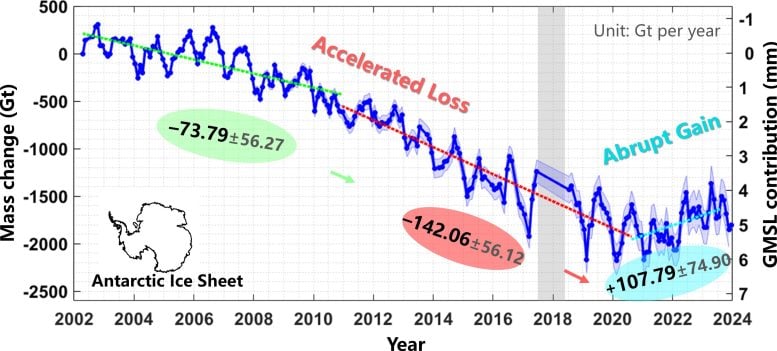
Antarctic Ice Gain: What Trump’s Science Allies Believe
The narrative surrounding Antarctic ice is often one of relentless melt and rising sea levels. However, recent findings have introduced a surprising twist: evidence of Antarctic ice gain. This development has resonated with a segment of scientists and policy analysts often aligned with the perspectives of the Trump administration. This post delves into what these allies believe about Antarctic ice gain and the implications of this complex scientific picture.
A Shifting Scientific Landscape: The Antarctic Ice Paradox
For decades, much of the focus on Antarctica has been on the perceived instability of the West Antarctic Ice Sheet, which is particularly vulnerable to warming ocean currents. This has fueled concerns about its contribution to global sea-level rise.
However, new data, often sourced from NASA satellites, is highlighting a more nuanced reality. Some studies suggest that, despite overall global warming trends, certain regions of Antarctica have actually experienced an increase in ice mass in recent years. This apparent paradox is central to the beliefs held by those who often find common ground with Trump’s science allies.
Key Findings Fueling the Debate:
- Regional Growth: While some areas, particularly in West Antarctica, continue to show signs of melting, other regions, notably in East Antarctica, appear to be gaining ice.
- Satellite Data Insights: Advanced satellite technology allows for precise measurements of ice sheet volume and mass, revealing these regional differences.
- Precedent in History: Some research points to historical periods where Antarctic ice growth has occurred, suggesting current patterns might not be entirely unprecedented within the broader climate history of the continent.
The Trump Administration’s Perspective on Antarctic Science
During his presidency, Donald Trump often expressed skepticism about the severity of climate change and sought to re-evaluate international environmental agreements. His administration’s approach to Antarctic science was characterized by a focus on national security and strategic interests, as well as questioning the prevailing scientific consensus on climate change.
Those who align with Trump’s science allies often emphasize:
- National Security and Leadership: They believe a strong U.S. presence in Antarctica is crucial for national security, deterring adversaries, and maintaining American leadership on the continent. This includes ensuring robust polar infrastructure.
- Economic Opportunity: Some proponents advocate for exploring potential economic opportunities in the polar regions, while emphasizing responsible resource management.
- Skepticism of Alarmism: This group often expresses caution regarding what they perceive as overly alarmist predictions about imminent climate disasters, preferring a data-driven approach that acknowledges complexities and uncertainties.
What Trump’s Science Allies Believe About Antarctic Ice Gain
For those who tend to agree with the policy direction and scientific critiques often associated with the Trump administration, the findings of Antarctic ice gain are significant. They interpret these developments as evidence that:
- Climate Models Need Refinement: The existence of regional ice gain challenges simplified models that predict uniform melting across the continent. They argue this highlights the need for more sophisticated and nuanced climate modeling.
- Antarctica is More Resilient Than Assumed: The observed ice growth suggests that the Antarctic ice sheet, as a whole, might be more resilient to warming than some dire predictions suggest.
- Focus on Specifics, Not Generalizations: They advocate for a focus on specific scientific observations and regional variations rather than broad generalizations about Antarctic ice loss. This approach allows for a more balanced understanding of the continent’s complex dynamics.
- Questioning the Urgency of Certain Policies: By highlighting areas of ice gain, these allies may question the urgency or scale of certain proposed climate policies that are predicated on universal Antarctic melt.
Navigating the Complexities: A Balanced View
It’s crucial to acknowledge that the science of Antarctic ice is inherently complex and subject to ongoing research. While some studies highlight ice gain in certain regions, others continue to document significant melting in other areas, particularly West Antarctica.
Consider this simplified overview of Antarctic ice sheet mass trends:
| Region | Recent Trend (General Observation) | Primary Drivers (Hypothesized) |
|---|---|---|
| East Antarctica | Ice gain observed in some areas | Increased snowfall, atmospheric circulation changes |
| West Antarctica | Ice loss observed in many areas | Warming ocean currents melting ice shelves from below |
| Antarctic Peninsula | Ice loss observed | Warming air and ocean temperatures |
It is important to remember that these are broad generalizations, and scientific understanding is constantly evolving with new data.
Actionable Takeaways for the Engaged Citizen
Understanding the debate surrounding Antarctic ice gain offers valuable insights for anyone following climate science and policy:
- Embrace Nuance: Recognize that scientific findings are rarely black and white. Look for research that acknowledges regional variations and complexities in polar science.
- Question the Simplistic Narrative: Be critical of overly simplified narratives that present a single, universally accepted story about Antarctic ice.
- Consider Multiple Perspectives: Engage with a range of scientific viewpoints and policy analyses, including those that may challenge prevailing narratives.
- Prioritize Data and Evidence: Focus on the quality and methodology of scientific studies. Understand how data is collected and interpreted.
- Stay Informed: The scientific understanding of Antarctica is a dynamic field. Continuously seek out updated research and expert analysis.
The discussion around Antarctic ice gain, particularly as viewed by those who align with Trump’s science allies, underscores the importance of critical thinking, robust scientific inquiry, and a balanced approach to understanding our planet’s most formidable icy continent. It’s a conversation that will undoubtedly continue as new data emerges from this vital region.

Additional Information
Antarctic Ice Gain: What Trump’s Science Allies Believe and the Scientific Nuances
The notion of Antarctic ice gain, particularly in contrast to global warming trends, has become a focal point for a segment of those aligned with former President Donald Trump’s scientific perspectives. While mainstream climate science generally acknowledges ice loss in specific Antarctic regions, particularly West Antarctica, the idea that the continent as a whole might be gaining ice, or that this gain is significant enough to warrant discussion, resonates with those who question the prevailing narrative on climate change. This perspective often emphasizes data that, when viewed in isolation or with a specific interpretation, appears to contradict the broader consensus.
Core Beliefs of Trump’s Science Allies Regarding Antarctic Ice Gain:
Those who align with this viewpoint, often referred to as “Trump’s science allies,” frequently articulate the following beliefs, drawing on certain scientific findings and interpretations:
- Focus on Localized Gains: A primary tenet is the assertion that while some areas of Antarctica, notably West Antarctica, are experiencing ice loss, the vast East Antarctic Ice Sheet is stable or even gaining mass. They highlight studies that indicate increased snowfall in certain regions of East Antarctica, which can lead to an accumulation of ice. Recent search results, such as the Live Science article citing NASA satellites showing ice gain, and the NY Post article mentioning a “surprising rebound in mass,” directly support this focus on areas of growth.
- Skepticism of Catastrophic Melt Scenarios: These allies often express skepticism about the dire predictions of rapid and irreversible sea-level rise stemming from Antarctic ice melt. They tend to downplay the urgency and magnitude of potential collapse, arguing that the ice sheet is more resilient than commonly portrayed.
- Emphasis on Natural Variability: A significant argument is that observed changes in Antarctic ice are largely attributable to natural climate cycles and variability, rather than solely to human-induced global warming. They might point to historical periods of ice growth or retreat as evidence that the current situation is not unprecedented. The Climate Cosmos article, suggesting “current ice growth patterns aren’t entirely unprecedented,” aligns with this line of reasoning.
- Critique of Media and Scientific Portrayal: There is often a belief that the media and the broader scientific community selectively report on Antarctic ice, focusing almost exclusively on areas of loss and ignoring evidence of gain. This leads to a perception that the “ice is growing” narrative is being deliberately suppressed or downplayed. The title “Antarctic Ice Is Growing—Why Won’t Anyone Talk About It?” from Climate Cosmos directly reflects this sentiment.
- National Security and Strategic Interests: For some within this group, understanding Antarctic ice dynamics is framed through a national security lens. The FAS.org publication, “Polar Infrastructure and Science for National Security,” proposes an Antarctic strategy to enhance U.S. national security, deter adversaries, and prevent disastrous ice sheet collapse. This suggests that a focus on stability or even growth in Antarctic ice could be seen as beneficial from a strategic standpoint, as opposed to a scenario of rapid melt that could destabilize geopolitical dynamics.
Analysis and Scientific Nuances:
While the assertion of Antarctic ice gain is not entirely without scientific basis, it requires careful context and a nuanced understanding of the complex dynamics of the Antarctic ice sheet.
- Regional Differences are Crucial: The Antarctic continent is enormous and experiences vastly different climatic conditions and ice dynamics.
- West Antarctic Ice Sheet (WAIS): This region is predominantly grounded below sea level, making it highly vulnerable to warming ocean waters. As warming oceans melt the ice shelves that buttress the WAIS, the glaciers behind them accelerate their flow into the sea, contributing to sea-level rise. This is where much of the scientific concern about ice loss is concentrated, as highlighted in the Carbon Brief article noting scientists ringing alarm bells about the melting of Antarctica focus on the smaller West Antarctic ice sheet.
- East Antarctic Ice Sheet (EAIS): This region is much larger and generally sits on higher ground, making it less susceptible to direct ocean warming. While some areas of the EAIS may be experiencing increased snowfall and accumulation, leading to localized ice gain, other areas, particularly coastal regions, are showing signs of ice loss. The overall picture for the EAIS is complex and still subject to ongoing research.
- The “Gain” is Not Uniform or Necessarily Compensating: Studies showing ice gain in certain regions of East Antarctica are often cited as evidence against a net loss for the continent. However, the rate of gain in these areas may not be sufficient to offset the more rapid loss occurring in West Antarctica. Therefore, even with localized gains, the continent as a whole might still be losing ice mass. The Live Science article, while reporting ice gain, also contextualizes it within “increasing average global temperatures and climate change,” implying a broader trend that the ice gain doesn’t negate.
- Definition of “Ice Gain”: It’s important to distinguish between increased snowfall leading to thicker ice in some areas and a net increase in the total ice mass of the continent. The former can occur even as the overall ice sheet is shrinking due to increased melting and calving of icebergs.
- Impact of Trump-Era Policies on Antarctic Science: The search results also highlight a significant tension between the Trump administration’s approach and Antarctic research. Articles from Nature and The Conversation point to President Trump’s “massive government cuts” and “deep funding cuts to his nation’s science and logistics on the icy continent.” This suggests a potential disconnect between the administration’s priorities and the scientific efforts needed to fully understand complex phenomena like Antarctic ice dynamics. If scientific endeavors are curtailed, it could hinder the very research needed to confirm or refute claims of ice gain or loss.
Conclusion:
The belief in Antarctic ice gain among Trump’s science allies often stems from a focus on specific regions of East Antarctica that may be experiencing increased snowfall and accumulation. This perspective can be amplified by a skepticism towards the broader consensus on anthropogenic climate change and a perception of biased reporting by mainstream sources.
However, a comprehensive scientific understanding of Antarctica reveals a more complex picture. While localized gains are possible and observed, they must be weighed against the significant and concerning ice loss occurring in West Antarctica, which is more directly impacted by warming oceans. The debate over Antarctic ice gain, therefore, underscores the importance of detailed, region-specific data, a nuanced understanding of climate processes, and sustained scientific investment to accurately assess the continent’s contribution to global sea-level rise in the context of a changing climate. The funding cuts mentioned in the search results raise questions about the ability to gather this crucial data and maintain a robust scientific presence in the region.






Leave a Reply